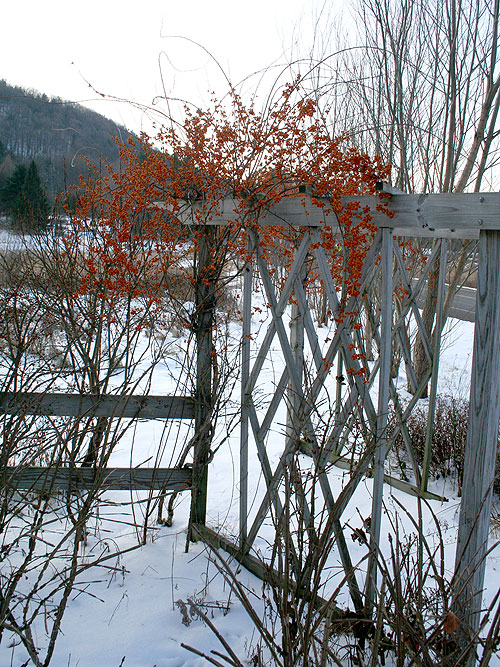Category: Bummers
Unfortunate subject line
The first editor I worked for warned me about asking hypothetical questions.
I think the world of Marie Iannotti over at About.com: Gardening, but the subject line from her opt-in email today could have used a second look before hitting send:
About Gardening: Is it Garden Worthy?
I’ve written my share of bad subject lines and headlines.  That said, Marie has started what could be a really garden-worthy thread with this question:
I ‘m curious to know what your experience has been with planting award winning or much touted plants in your own gardens – good or bad. Use the comments link below and clue us in to which plants would you recommend and which should we avoid?
To which I commented:
If I recall correctly, one of the criteria for AAS winners is ‘widely adapted’ — so they should perform well for most gardeners. But I’m more apt to look for plants that are peculiarly adapted to my situation as opposed to those that will do OK all over.
Garden Bloggers’ Design Workshop: Arbors, Pergolas (and the midnight bowling ball accident of 2003)
As many of your know, I’m not a real stickler when it comes to garden design, usually preferring the ‘shovel and pot’ method. (Wandering around the yard with a shovel and a plant in a pot until I find an empty spot to stick it.) But I have to admit, I did go through something of a design process that led me to build a small pergola.
It’s a long story (especially getting to the bowling ball accident) that I will try to tell quickly. This aerial view will help you get oriented a little. That’s our house on this, the south side, of the road in 2006. My big point here is that — while out back we have a great view — out front we are annoyingly close to an often busy road. (It’s the shortcut to Cornell University from points east.) There’s an intersection just east of our house, so vehicles are either picking up speed or downshifting (especially the quarry trucks) as they go by our house.
When we moved in in August 1999, there was next to no landscaping. It seemed like the road ran right outside our living room window. Here are some images I took that fall with an old Casio digital camera:
Looking west from our front porch in fall 1999 with some heavy mulch to start defining a corner bed:
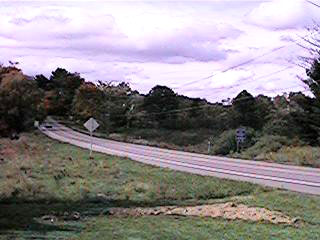
Looking at the house from the northeast — road, lawn, driveway, front yard:
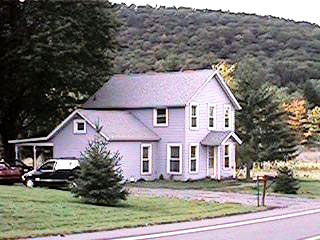
Looking from the eastbound lane right into our living room windows:
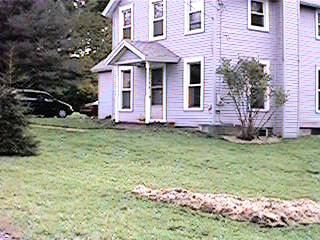
It doesn’t take a degree in landscape architecture to know that we needed some visual separation from the road. But I also wanted something physical to define the yard in front of the house. On the east side of the yard, I put in a low, two-rail fence along the edge of the driveway with a break for the walk leading to the front door.
On the west end of the front yard, I wanted to put up a similar fence to define that end of the yard, but wanted to be able to walk through it so that I could get from the front yard to the ‘wild’ areas beyond. Instead of the simple break in the fencing on the east side, I decided to build a small pergola that would also provide something of a screen between our living room windows and the road.
Here it is a few weeks ago with bittersweet berries showing:
The sides are only 6 feet long with the top rails running 8 feet. But the visual impact is made larger because its footprint is diamond-shaped with the long axis running perpendicular to the sight line running northwest from our living room windows.
I’m not claiming that it erased the road, but combined with the willows and other shrubs and plantings that are coming along the road no longer seems to run through our living room.
The diamond design in the side panels I found in an old book of garden construction ideas. If I recall, it was a design used for screen window frames for porches and summer houses.
You can see the rail fence running south 16 feet farther into the yard. There was an 8-foot section extending from the other side of the pergola toward the road when I built it. All the wood is just cheap pressure-treated stuff that’s mellowed from that awful green to a nice gray.
I say when I built it because that section is not there any more. Which leads me to the great bowling ball accident of 2003.
At 4 a.m. on April 12, 2003, Elly and I were awakened from a deep sleep in our second-floor bedroom by a loud crash, followed by the spinning of tires outside our window. By the time we got to the window, the driver gave up getting out and was walking away. Knowing that at least the driver was in good enough shape to walk away, we called the police. They picked up a young man not far down the road walking home. He had worked a double shift and fell asleep at the wheel, drifted off the road, through the outer fence and into the yard, burying the car up to its axels in the mud.
Our old Casio camera had dies by then, so the next morning Elly wandered around with her laptop and video cam shooting pictures of the scene:
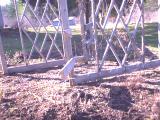


Fence snapped off pergola, ruts and car looking east, view from porch.


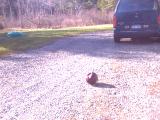
Looking west, view from bedroom, the bowling ball in the driveway.
She also shot a couple short .avi videos of the scene: Video 1 | Video 2
Oh yeah. Almost forgot about the bowling ball. One of my tacky lawn ornaments out front was a red bowling ball on a length of rebar looking like a giant cherry tootsie roll pop. The kid hit it on his way through the yard a knocked it 50 feet into the driveway. It’s the first thing I saw when I left the house shortly after 4 a.m. to investigate what happened and immediately thanked my lucky stars that he didn’t knock it up into the air and have it come crashing down through the windshield.
I rescued the bent rebar and re-installed the ornament so that now the ball hovers ethereally just over the soil — in the backyard.
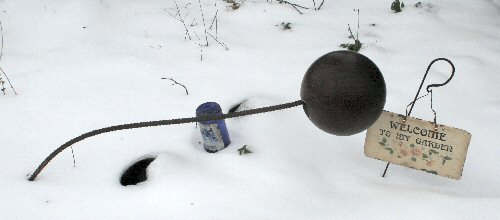
My name is Craig and I have a houseplant problem
 With all of us in the northern climes being driven inside, there’s been a lot of blogging about houseplants.
With all of us in the northern climes being driven inside, there’s been a lot of blogging about houseplants.
When I read that Kim over at A Study in Contrasts had nearly 50 pots-worth, I said to myself, “I’m glad I’m not saddled with that burden during the winter.”
You see, we live in a lousy house for houseplants. Sunny south windows are few. The windowsills are narrow. And when it comes to nuance houseplant care, I’m not your guy.
Any plant that can’t go a week (or two) without watering is a goner. That said, I’ve killed my share of plants from overwatering.
So there’s no way I’d have as many pots as Kim.
Then I figured, maybe I should take an inventory just to make sure.
When you come into the kitchen, you’ll notice the burrow’s tail (apologies for my lack of precision in naming these plants). It’s a great pass-along plant because it roots so easily. I got my start from a neighbor more than 15 years ago and it’s been repotted or restarted from cuttings numerous times. That’s 1 pot.
On the kitchen table, three poinsettias from the sale last week on campus by the Hortus Forum student horticulture club, and a bromeliad someone abandoned at work. 4 more makes 5. (I gave one of the poinsettias away to my mother-in-law already, but I’m still going to count it.
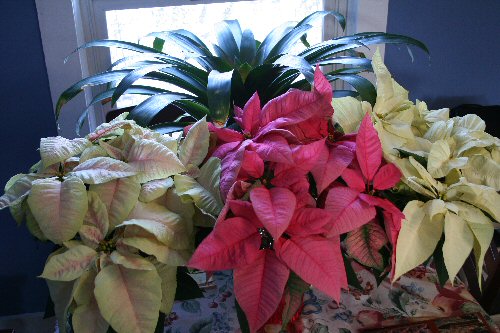
On the kitchen windowsill, a couple of violets, a couple of florists cyclamen from the Hortus Forum plant sale, and an orchid given to me by a friend that I haven’t yet killed. 5 more makes double figures already.
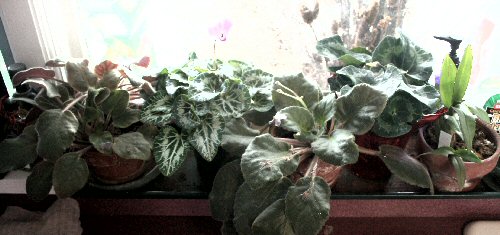
On to the sitting room: The cactus pot (wow, that cactus really doesn’t like frost) and my Ficus religiosa, which I cut all the way back this year in an effort to get the scale under control. (OK, so that’s one plant I will fuss over. But hey, this is the tree under which Budha gained enlightenment. I want a stone Budha for the garden, but I’ll settle for the tree.) In the west window, 5 more pots including the calla my friend Billie Jean gave me for helping to move plants into her sunroom and a pot of amorphophallus. That’s 7 more pots or 17 all together.
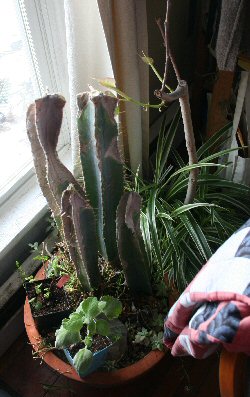
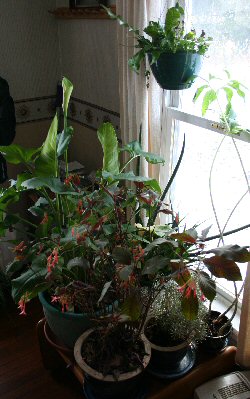
On to the living room: Not much here. Just the hanging fern that was given to Elly by her co-workers when my mother died about 15 years ago, and a pot of aloe. 2 more makes 19.
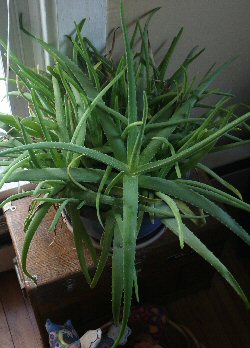
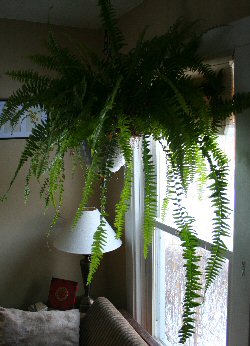
The foot of the stairs with bright north and east windows is a crowded spot. Some big philodendrons, a spiralling Dracaena from a rooted cutting 20 years ago, some overwintering lantanas, and some smaller pots on the plant stand. Oh, and the spider plant hanging in the stairway. Another 11 makes 30. I’m getting into Kim range, but there’s only one room left to go.
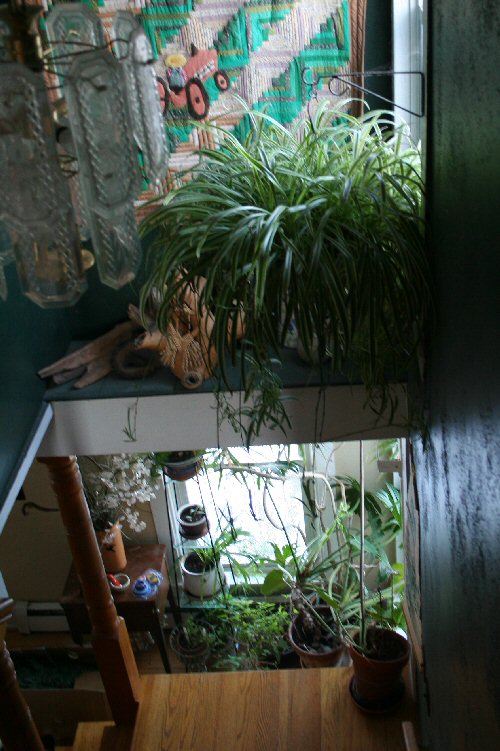
Upstairs spare bedroom: These shouldn’t really count, should they? We keep the door short and it’s really just a holding area for pots with mostly dormant plants in them. Brugmansia, Abutilon, geraniums, etc. 13 all together. That makes 43, so I don’t have Kim’s houseplant monkey on my back. At least not as firmly on my back.
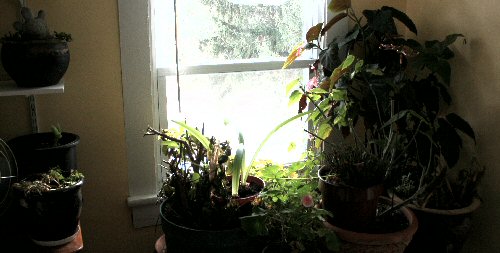
Oh yeah. I forgot about work. The Plant Science Building where I work has great big windows with wide sills, and while my office faces north, I scatter a few plants around other offices with south-facing windows. The dozen raggedy plants (most prominent, another amorphophallus) in my office window shoots me past the Kim-zone to 55.
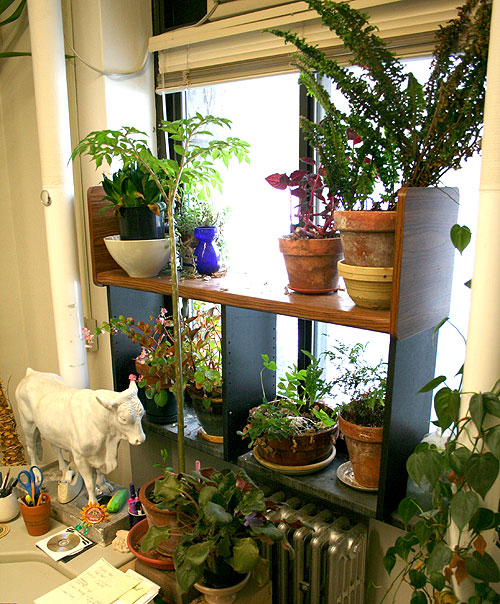
Four more in the back office makes 59.
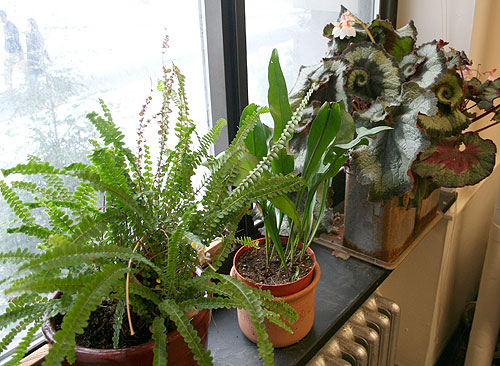
There’s the 12-foot tree (I’ve forgotten the name, but one of our Mexican grad students tells me it’s common in the deserts down there) behind my desk, and the snake plant in the main office. Up to 61.

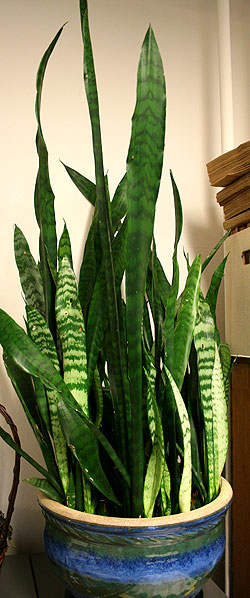
The south-facing windows in the lunchroom (right over the radiators) are great for cacti and succulents. Three on each sill. That’s 67.
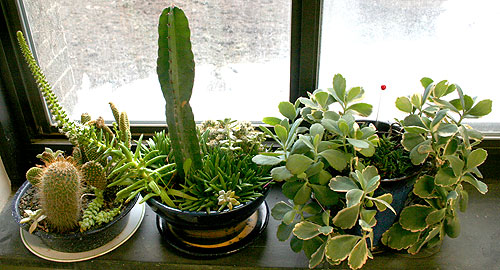
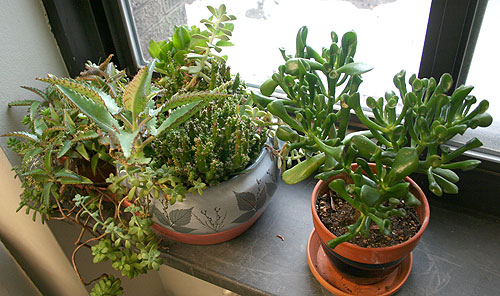
There’s the monster aloe in my friend Annie’s office. (68)
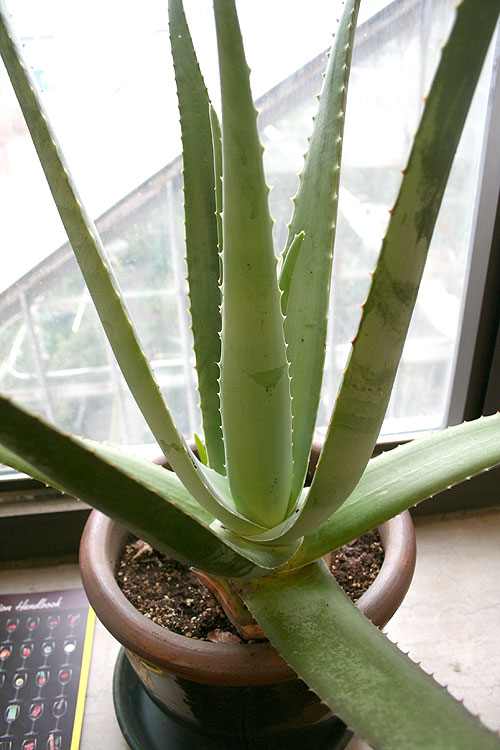
And the euphorbia in the weed science folk’s office.

So if my math is right, that’s 69 — not counting the dozen or so plants I sent to school with my daughter or the bananas, brugmansias and tropicals I’m trying to overwinter in my sister-in-law’s cellar.
Thank goodness I’m not into houseplants.
Jah have mercy, I think I have a problem. But it’s a good problem. These plants bring me much joy, and they’re not all that hard to take care of. They get me through the winter.
And in the darkest days at work, I don’t have to depend on these plants alone. Just down the hall is the Libery Hyde Bailey Conservatory, where it’s always warm and where some incredible plants reside waiting to educate the next generation of botanists.
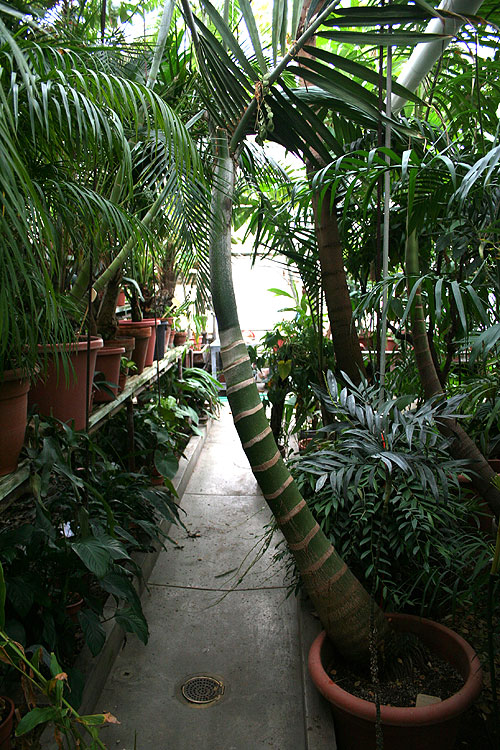
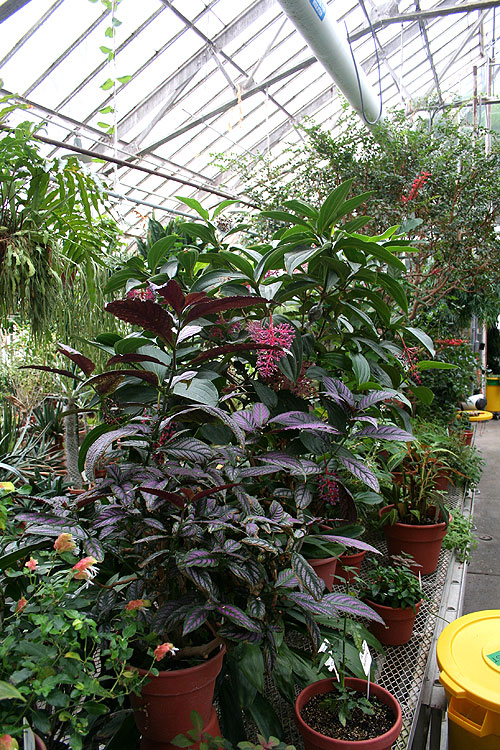
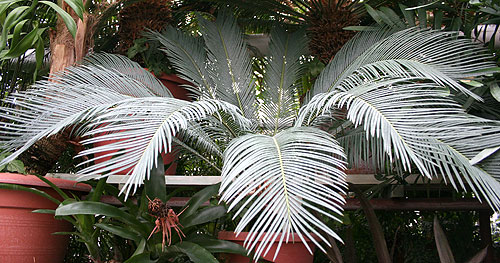
So how do you really feel about Martha Stewart?
Lippanzer stallions and lawn fertilization on Martha Stewart via Huffington Post.
I’ll admit it: I have a friend who occasionally passes along Martha Stewart Living magazine. Everything in it is well done and there are always a few articles that I really enjoy.




